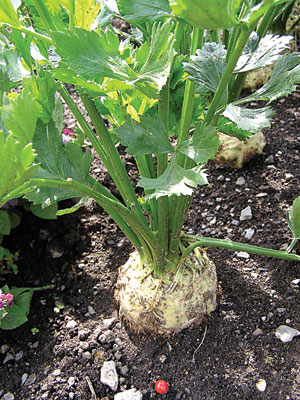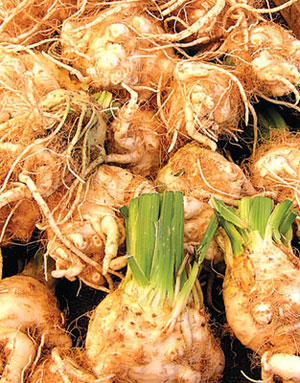 |
| Celeriac growing in a garden in mid-August. English photo |
 |
| Harvested celeriac. English photo |
By Jean English
If you’ve had trouble growing good celery, maybe celeriac is the vegetable for you. This biennial, Apium graveolens var. rapaceum, is somewhat easier to grow than its fussier relative, celery; its edible part – a fleshy rootstock – adds a celery-like taste to plenty of dishes; and it lasts a long time in storage – just what we need for a Maine winter.
Celeriac grows slowly, takes about 100 days from transplanting to mature, and its best flavor develops in the cool days of fall. Start plants indoors in early March; they’ll take two to three weeks to germinate and take the rest of the spring to produce sizeable enough transplants to put in the garden during the first half of June. The plants do best in a rich, compost-amended, regularly watered soil – as does celery.
Transplants should be grown 6 to 8 inches apart within rows, and rows should be 2 to 3 feet apart.
Harvest celeriac from September through the fall, when the fleshy roots reach a diameter of 3 to 5 inches. Larger, older roots tend to be woody.
Store celeriac roots (with leaves removed) in a moist, cold environment – in dampened sand, sawdust, leaves or wood shavings, for instance, and in a root cellar where the temperature is near freezing. Fedco Seeds says that the roots will store up to six months under these conditions. Indeed, at one of MOFGA’s Farmer-to-Farmer Conferences several years ago, Eliot Coleman reported that he was taking celeriac and beets out of storage even in July.
What do you do with those roots once they’re in the kitchen? That question seems to be the stumbling block to celeriac’s popularity. In its raw state, it’s got a long way to go before it’s as pretty as a rainbow assortment of carrots or a ‘Ruby Red’ cabbage slaw. It’s “the frog prince of root vegetables,” according to an old Fedco catalog, because of its ugly exterior.
“Celeriac is one of the most likely veg box veggies to end up in the compost bin,” says the website VegBox Recipes (www.vegbox-recipes.co.uk/ingredients/celeriac.php), which tells how to use produce from “vegetable box schemes” as they’re called in Britain (community supported agriculture farms here). The key to having tasty celeriac, adds VegBox, “is to peel it and slice it just before using, or it turns brown quickly. And, if you’re boiling it, adding it straight to boiling water, rather than cold, helps to reduce the bitterness.”
Here are some cleaning and cooking tips:
• Remove leaves and rootlets from celeriac roots, and scrub the fleshy roots with a vegetable brush.
• Use celeriac leaves in salads or soups.
• Cut the hollow leaf stalks to drinking straw length, rinse them, and sip tomato-based drinks through them to add a celery flavor to those drinks. Bloody Mary, anyone?
• To make the roots easier to peel, try boiling them first, then peeling them and slicing them into a salad or adding chunks to soups, stews and sauces. Slice the outer surface off with a knife; don’t try to remove it with a vegetable peeler.
• You can also slice the raw roots and then remove the outer skin.
• To minimize browning, slice roots just before cooking and/or put them in a bowl of acidulated water (3 Tbsp. lemon juice or vinegar per quart of water) as you cut them.
• Use raw celeriac root cubed or shredded in salads.
• Use celeriac root in soups and stews.
• Mash the boiled cubes and serve like mashed potatoes.
• Add celeriac root to casseroles, gratin dishes or roasted vegetable medleys.
